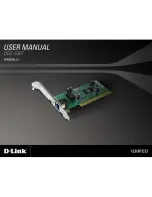
Troubleshooting
A–2
Diagnostic Test Errors
The following table describes the common diagnostic errors and the
recommended corrective actions:
Symptom
Possible Cause
Recommended Actions
The LNK LED does not light
after making a TP connection.
Invalid TP link.
Check the 8-pin MJ connection for loose cabling.
Check for incorrect pin assignments.
Running the Test Adapter
routine results in External
Loopback Test failure.
Reboot the system, then run the test again.
The ACT LED flashes on and
off after making a coaxial cable
connection resulting in adapter
failure.
Faulty coaxial cable
link.
Check the BNC connection for loose cabling.
Verify that both ends of the network segment are
properly terminated. Terminate the open end of
the network segment with a 100-ohm terminator.
Adapter failure; unable to log in
to the network.
Faulty cable connection.
The host PC slot is
defective.
Adapter is not properly
installed in the slot.
When making a TP connection, check for loose
cabling or an incorrect pin assignment.
Install the adapter in another PC. If the problem
is eliminated, then the original PC slot is
defective. Contact your reseller or Digital Service
Representative for assistance
Ensure that the adapter is properly seated in the
slot.
Adapter fails after
configuration.
Configuration conflict.
Check the I/O address and the IRQ for possible
setting conflicts. If the I/O address range for your
PC overlaps that used by the adapter, then reset
the adapter’s address to another setting using a
1Step command from the DOS prompt (for
example, C:\> 1Step/1:280).
Run Autoconfigure Adapter from 1Step to
automatically set up the adapter configuration.
Frequent adapter failure.
Bus timing conflict for
the channel ready
(CHRDY) signal
between the adapter and
the host PC.
Run 1Step and set Bus Timing to Early. The
incompatibility between the PC AT-bus and the
adapter CHRDY signal often results in adapter
failure when using the adapter in early PC
versions..













































